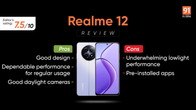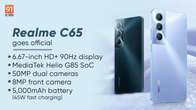Saying that Chinese smartphone maker Realme has come out swinging in the Indian market this past year would be a grave understatement. Realme has pushed itself to the fifth gear and has come out all guns blazing with the intention of dominating most of the price segments in India. The rivalry between Realme and Xiaomi, which had earlier been scoffed upon given the former’s recent entry into India, has been blown out of proportion with the companies coming out with competing products within weeks of each other. In the end, this is what is benefitting consumers the most as they are getting incredibly specced devices at affordable prices.

The Realme X2 had been teased earlier back in October when the company had announced the Realme XT (review). At the time we had been told that the X2 would be called the Realme XT 730G, which by all means is a confusing title. The Realme X2 makes more sense since in a way this device is a stripped-down version of the Realme X2 Pro (review), which had been launched last month. With the Redmi K20 (review) in its crosshairs and most likely also the upcoming Redmi K30, the Realme X2, priced starting at Rs 16,999, is an all-round device which could quite likely be the most powerful mid-range phone in the market right now, but for how long? I had the phone for a week and here is what I think about it.

- No application fee
- No down payment required
- No pre-closure fee
Design and display
From the outside, the Realme X2 is all but indistinguishable from its elder sibling X2 Pro. This is a trend that has been seen with several Chinese smartphone makers while releasing cheaper versions of their main phones. For instance, the Realme 5S (review) and Redmi Note 7S (review) launched as stripped-down versions of the Realme 5 Pro (review) and Redmi Note 7 Pro (review) respectively. However, I digress. The Realme X2 has a glossy polycarbonate unibody design which has become a staple for smartphones in this price range. The variant I received has the Pearl Green colour with a dual-tone finish, giving it two different shades of green when looked at from different angles. I’ll have to give it to Realme for making the phone drop-dead gorgeous, but again it comes at the cost of the device being a fingerprint magnet. Then there is also the fact that you’ll most likely have to slap a case on the phone on account of it being as slippery as a phone can get. Personally, I prefer the matte finish that Google has opted for the Pixel 4 on the back and on the sides, which give the phone an appealing look while also offering a firm grip.

On the front of the phone, we see the familiar teardrop-style notch on the top and thin bezels along the sides, which Realme touts has given the device a 92 percent screen-to-body ratio. The phone is covered on both sides with Corning’s Gorilla Glass 5 which could give sufficient protection, at least from minor scratches. The back of the phone is clearly dominated by the quad-camera setup aligned vertically, something that in recent months has been slapped on to quite a few mid-range and budget smartphones. There is no fingerprint sensor on the rear as Realme has opted for an in-display variety on the front. As for the ports and button, there’s a headphone jack, a Type-C port, a speaker grille and a mic, along with volume rockers on the left and the power button on the right. All of this is pretty much standard for the Realme’s mid-range lineup.

Diving slightly deeper inside the display, we see that Realme has used a 6.4-inch FHD+ Super AMOLED panel on the phone. This almost exactly the same as the X2 Pro with the only difference being the absence of the fluid 90 Hz refresh rate that is found on the latter. Being a OnePlus 7T user, I can say first hand that a higher refresh rate is perhaps the best display features you can have on your smartphone but I guess compromises have to be made when you are selling a device at an affordable price. However, the X2 does boast several other display features such as OSIE Vision Effect which is basically a fancy word for pumping up colours on the display, Low-brightness flicker-free eye care which will reduce visual fatigue caused by screen flickering at low brightness, a Night Shield for filtering out blue light during night time usage and the ability to choose from two colour modes, ie Vivid and Gentle. In my opinion, you would do well by keeping your phone’s colours to Vivid, as that provides a far better visual relief in terms of colour temperature and crispness as compared to Gentle, which has a dull vibe to it. The brightness levels of the display were consistent with what I had expected and whether it was indoor viewing or outdoor viewing, I never had a problem with the Realme X2.

Cameras
I feel that the camera section for this review is a tad bit unnecessary and the reason is that the X2 has an identical camera setup as the Realme XT. The only difference I can possibly make out is the latter’s image processing capabilities should, in theory, be better than the former due to a marginally better chipset. As it turned out, this was not the case.

Like the XT, the Realme X2 also comes equipped with a bevy of camera lenses of varying focal lengths and capabilities. There’s a 64MP Samsung ISOCELL sensor as the primary shooter and it is supported by an 8MP super-wide-angle lens with a 119-degree field of view, a macro sensor with an f/2.4 aperture and a 4cm focus distance and finally, a 2MP portrait camera for… you guessed it, clicking portrait photos. While I welcome the inclusion of so many options for clicking photos, it is also pertinent that the execution be not flawed to the point that the consumer wonders whether so many features are more akin to a gimmick. I say this because of the poor response that Realme 5 and 5 Pro’s macro camera received and also because the macro camera is not something many people tend to use day-to-day. That being said, the Realme X2’s camera did not leave me impressed, but for a phone costing Rs 20,000, it does get the job done.
The 64MP camera is both good and bad. On a regular day the phone will shoot 16MP photos which are crisp, full of detail, and generally have a good colour balance. You can amp up the details by shooting in the “Ultra 64MP” mode if you want, which uses the Pixel-binning technology to combine four detailed 16MP shots into one. The resulting photo is quite bright and packs in more detail and as you can see in the photo comparison below, the 64MP shot is clearly more saturated than the normal shot but it does bring in great dynamic range.


There is no zoom lens on the Realme X2 but it does come with a super-wide-angle lens which, in my opinion, has more merit than a zoom lens anyway. At 119-degrees it is one of the widest lenses you will see on a mid-range smartphone and it shows in the photo-taking capabilities. It gets in a lot inside the frame than a regular wide-angle lens, and this has a good use case when you are clicking photos of huge landscapes. However, the super-wide sensor makes a mess of colour temperatures and exposure calibrations.

The portrait and macro sensors on the device are up to the mark or rather as I had expected it to be after seeing the image quality on the Realme XT. The background separation is good on the portrait lens while the macro lens, while keeping good details of objects, fails miserably in colour reproduction. The selfie camera on the phone is also decent but it seems that OPPO, Realme, Vivo and Xiaomi are constantly attacking my face with artificial beauty filters even after I explicitly turn them off. The background separation for the front portrait mode is good as is the edge detection, though I see familiar qualms of poor exposure handling.
The Realme XT handles night photography relatively well and I expected the same to be passed on to the Realme X2, which it does. The dedicated Night mode on the phone brightens up an extremely dark photo and while it does its best to preserve details, it comes at the cost oversharpening, noise and bad dynamic range.
Performance, Software and Battery
The Realme X2 comes with the Snapdragon 730G chipset announced in early 2019. The advantage of the 730G over a standard 730, like the one seen on the Redmi K20, is that the former has 15 percent increase in GPU performance which translates into a better gaming (read as PUBG Mobile) experience. The only other phone to sport the 730G in India was the Reno 2, which costs nearly twice the X2 while offering nearly the same performance specs. However, the problem here is the fact that in just a month from now, we are going to see some smartphone makers coming out with the recently-unveiled Snapdragon 765G, prime among them being the Redmi K30 5G which is expected to launch in India next month, after having been unveiled in China. If the rumoured pricing is anything to go by, the K30 5G will be flirting in the X2 territory which would be bad for Realme. However, for the here and now, the Realme X2 is quite possibly the fastest phone in the mid-range segment (the Poco F1’s Snapdragon 845 could be more competent but it is more than a year old now). For day-to-day tasks such as the opening of multiple heavy apps like Facebook, Instagram, and several Chrome tabs at once did not deter the performance of the phone even once.

As far as gaming is considered, you might have guessed by now that the Realme X2 is no slouch. The 730G chipset provides for a more than ample experience of no-lag gaming on graphics-intensive titles such as PUBG Mobile, Call of Duty Mobile and Asphalt 9. The frame rate settings are locked on to heavy for PUBG unlike phones with Snapdragon 855/845 chipsets which have the option of extreme. In short, gaming will not be of any concern and neither will be heating on the phone. The additional software support with things such as Game Space wherein you can free up RAM, allocate resources for a better experience and also summon an exclusive Game Assistant really do help the X2’s case.

In terms of biometric authentication, the phone features fingerprint unlock and facial recognition both of which work expeditiously on the X2, although the latter does struggle in low-light conditions. Basic things expected from a phone such as a call and a microphone quality along with speaker volume are all up to the mark.

Software-wise you surprisingly get Android 9.0-based ColorOS 6.1, even though it has been quite some time since Android 10 has been released. There is nothing much about ColorOS 6.1 that I can say which hasn’t already been covered in our detailed review of the Realme X2 Pro. It is a relatively better skin than some of its other Chinese counterparts while the user interface is also quite good. That being said, OPPO’s ColorOS 7.0 is quite likely going to be introduced for the X2 and X2 Pro soon and Realme has said that it would be very close to stock Android on its devices. We’ll have to see how true the claim is, but if the Chinese smartphone maker is aiming for a near-stock Android experience, it will win brownie points for me.

The Realme X2, like the X2 Pro, comes with a 4,000mAh battery. The only difference is that while the X2 Pro offers mind-boggling 50W Super VOOC charging, the X2 offers a 30W charging solution. To be clear, 30W charging is not bad in any sense of the word especially when you see that the iPhone 11 packs in a measly 5W charger while costing nearly triple. You will, however, miss out on the lightning-fast speeds that the X2 Pro has which can charge up your device to nearly 80 percent in about 30-35 minutes. Our regular battery drain test, which involves a continuous looped playback of a video at 50 percent volume and brightness, showed that the phone lasted about 17 hours. In comparison, the Realme 5S’ 5,000mAh battery managed 30 hours in our test, which makes the Realme X2 a decent device in terms of battery. In real-world usage, the phone has easily lasted me a day although nearly all phones in this price-range are doing the same.
Verdict
Pricing is key for Realme phones as they have a ton of devices separated marginally by price while offering much more key improvements in areas such as performance and camera. The only real difference between the Rs 15,999 Realme XT and the Rs 16,999 Realme X2 happens to be the Snapdragon 730 G on the latter. Similarly, the Realme 5 Pro priced at Rs 13,999 has a lower-powered Snapdragon 710 SoC and a 48MP camera instead of the 64MP sensors on the XT and X2. These are all very compelling phones and I really have to hand it to Realme for its consumer-first approach.

My only argument to buy the Realme X2 would be if you are into gaming as this device is clearly marketed towards power users at an affordable price. Add to that a rumoured near-stock Android experience and capable cameras, and you have yourself a winner on your hands. Till Redmi comes out swinging with the K30 (most probably early next year), the X2 is the phone to buy for a budget of Rs 20,000 since the K20 is now relatively old and offers lower internals. With the Realme X50 also being in the pipeline next year, the battle to dominate the Indian smartphone space is going to be quite interesting between the former OPPO sub-brand and currently India’s biggest smartphone maker.
Editors rating: 4 / 5
Pros:
- Great performance
- Good daytime photography
- Decent battery
Cons:
- Chipset will soon get outdated
- Poor night time photography


































